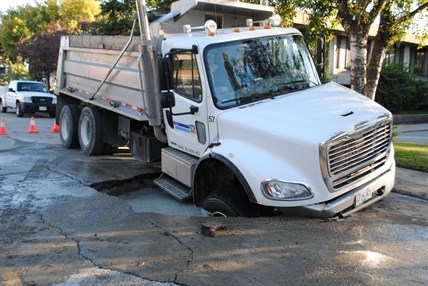
The wheel of a Vernon city dump truck became stuck in a sinkhole Oct. 2, 2014.
Image Credit: City of Vernon
December 08, 2014 - 3:25 PM
VERNON - Costs of aging water pipes are beginning to pile up in the City of Vernon with 86 water main breaks in just the last three years—four of them this month.
And the costs are not just in dollars and cents. Breaks on Nov. 25 left over 100 residents without water. Earlier in the year, a water line ruptured and flooded the Vernon Public Art Gallery. We also heard about a city dump truck that collapsed into a sinkhole, likely caused by a water flow from a broken water main. According to the city, there have been 28 water main breaks to date, another 25 in 2013 and 33 in 2012.
And while Barry Baker, the City’s utilities manager, chalks it up to “social media” and the work of a new communications person informing residents about the activity, the real problem is the City’s water pipes that are nearing the end of their life expectancy. He estimates it costs between $2,000-$8,000 for an emergency main repair, not to mention the disruption to residents.
For context, Vernon has nearly twice the failure rate of nearby municipalities. The City of Penticton reports half as many, with 15 to date, and 11 in 2013. The City of Kelowna had even less, averaging six to eight per year.
The service is provided through the Greater Vernon Water utility, and manager Zee Marcolin says Vernon’s city water is run through pipes that, in many cases, are 50 years old.
“It’s kind of a neglected area. I don’t think it’s fully appreciated that once you put the pipes in the ground you have to replace them,” Marcolin says. “There’s been a lot of work and money put in over the last ten years. We’re slowly chipping away and it’s improved quite a bit, but there’s still a lot of work to be done.”
Infrastructure renewal has moved to the forefront over the last decade, and Marcolin says the utility committed to $2 million a year strictly for upgrades.
“Even with $2 million, it will be a number of years before we catch up on our backlog,” Marcolin says.
A partnership with the UBCO engineering department has researchers creating an inventory of work that needs to be done, including areas that need immediate attention. The age of the infrastructure, the pipe material, and the history of water main breaks will help determine where the priorities are.
The water system faces some specific challenges; first, many of the network’s pipes are made of cast iron, which tends to corrode in the clay soils found around Vernon. Another compounding factor is terrain.
“Because Vernon is so hilly, we use a lot of pressure reducing valves,” Marcolin says. When it’s coming down from (the watershed) there’s so much pressure that without valves, the pipes would blow up.... If you have old pipes that are corroded, they fail.”
Adding to the pressure is the size of their network of pipes. Close to 700 kilometers in its network makes it the third largest utility in the province, Marcolin says, adding it's part of the reason Vernon experiences more failures than municipalities like Kelowna and Penticton.
NOT JUST PIPES
According to the City of Vernon’s infrastructure management technician Chris Thompson, the city is aware it faces challenges with aging infrastructure across the board—including road, drainage and facility infrastructure. He says aging infrastructure is an issue throughout North America stemming from an upswing in development after World War II.
“The city is making its best efforts to evaluate and spend its money as wisely as possible,” Thompson says.
The majority of Vernon’s infrastructure has a lifespan of about 45 years, and on average, the city is about halfway through those lifespans, Thompson says.
“That means we’re definitely in a situation where we have to start planning for the future,” he says.
Between a 1.9 per cent tax increase strictly for infrastructure renewal over the next ten years and a dedicated priority action approach, Thompson is optimistic the city can keep up with the upgrades. As much as possible, the city is trying to replace aging infrastructure before it goes.
“The costs to do an emergency repair are astronomically higher than doing a planned repair,” Thompson says. “It also increases the affect on the community.... When it’s planned we can accommodate them and have the interruptions be minimal.”
To contact the reporter for this story, email Charlotte Helston at chelston@infonews.ca or call 250-309-5230. To contact the editor, email mjones@infonews.ca or call 250-718-2724.
News from © iNFOnews, 2014